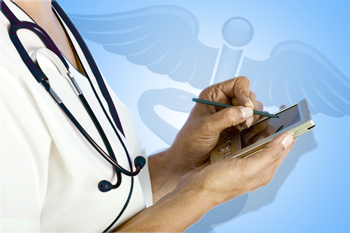For Consumers
FDA Proposes Health 'App' Guidelines
Click the button below to submit a comment on the proposed guidelines: |
 |
 Get Consumer Updates by E-mail
Get Consumer Updates by E-mail
 Share copies of this article (483 KB)
Share copies of this article (483 KB)
Want to know how a medication might affect your breast milk? Got a question about a disability, aging, mental health?
There’s an app for all that—and a whole lot more.
The variety and availability of smartphone applications—or apps—have exploded in recent years as multi-tasking consumers increasingly use their phones to keep up with the latest on news, finance, and health. Apple says its iPhone App Store has more than 350,000 apps, and Android, BlackBerry, Windows, and other smartphones account for tens of thousands more. With so many apps on the market, it’s no wonder the number of health care related apps has also spiraled.
The Food and Drug Administration (FDA) is now proposing guidelines that outline the small number of mobile apps the agency plans to oversee—medical apps that could present a risk to patients if the apps don’t work as intended. The proposed guidelines were posted on the Federal Register website Thursday.
Consumers may weigh-in on the guidelines during a public comment period that ends Oct. 19.
For more information, visit FDA's Mobile Medical Apps page.
FDA policy advisor Bakul Patel says some of the new mobile apps are designed to help consumers manage their own health and wellness—like the National Institutes of Health’s LactMed app, which gives nursing mothers information about the effects of medicines on breast milk and nursing infants.
Other apps are aimed at helping health care providers improve and facilitate patient care—like the Radiation Emergency Medical Management (REMM) app, which gives health care providers guidance on diagnosing and treating radiation injuries. There are even apps to aid diagnosis of rashes and heart irregularities.
FDA has already cleared a handful of mobile medical apps used by health care professionals, such as a smartphone-based ultrasound and an application for iPhones and iPads that allows doctors to view medical images and X-rays.
There's an app for that!
“There are advantages to using medical apps, but consumers and health care professionals should have a balanced awareness of the benefits and risks,” Patel says.
Apps can give consumers valuable health information in seconds and are opening innovative ways for technology to improve health care, Patel says. However, the small group of mobile medical apps FDA proposes to oversee present a potential risk—these apps may impact how a currently regulated medical device (such as an ultrasound) performs, he adds.
FDA is proposing to oversee mobile medical apps that:
- Are used as an accessory to an FDA-regulated medical device. For example, an app could enable a health care professional to view medical images on an iPad and make a diagnosis;
- Transform a mobile platform into a regulated medical device. For example, an app that turns a smartphone into an electrocardiography, or ECG, machine to detect abnormal heart rhythms or determine if a patient is experiencing a heart attack.
If you want to provide input on FDA’s proposal, you can submit your comment online at http://www.regulations.gov/ or in writing to: Division of Dockets Management (HFA-305), Food and Drug Administration, 5630 Fishers Lane, Rm. 1061, Rockville, MD 20852.
“We want to hear from as many consumers, advocacy groups, health care professionals, and software creators and distributors as possible to help us finalize the proposed guidelines,” Patel says.
This article appears on FDA's Consumer Updates page, which features the latest on all FDA-regulated products.
Posted July 19, 2011









